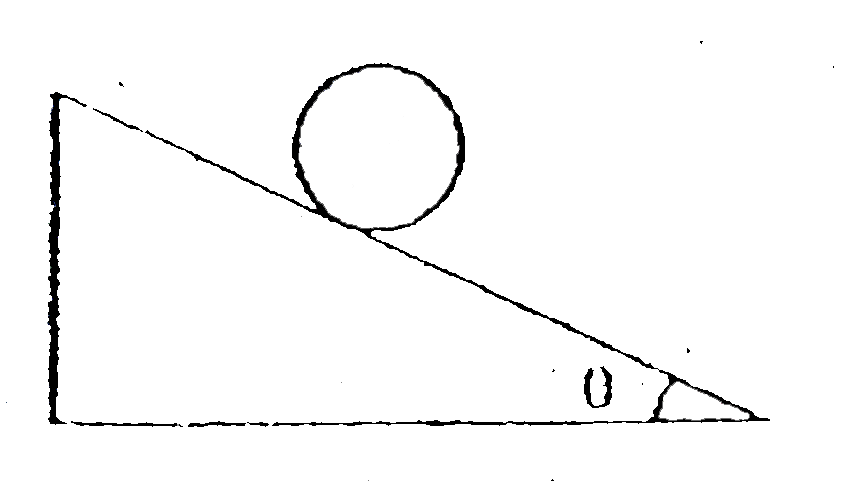A uniform, thin cylindrical shell and solid cylinder roll horizontally without slipping. The speed of the cylindrical shell is v. The solid cylinder and the hollow cylinder encounter an incline that they climb without slipping. If the maximum height they reach is the same, find the intial speed v' of the solid cylinder.
The correct Answer is:A
To solve the problem, we will use the principles of conservation of energy and the moment of inertia for both the hollow cylindrical shell and the solid cylinder.
1. Identify the Initial Conditions:
- Let the initial speed of the hollow cylindrical shell be v.
- Let the initial speed of the solid cylinder be v′.
- Both objects roll without slipping and reach the same maximum height h on the incline.
2. Write the Energy Conservation Equation:
- The initial kinetic energy (KE) of the hollow cylindrical shell is given by:
KEhollow=12mv2+12Ihollowω2
- The moment of inertia I for a hollow cylindrical shell is Ihollow=mr2.
- The angular velocity ω can be expressed as ω=vr.
- Thus, the kinetic energy becomes:
KEhollow=12mv2+12(mr2)(vr)2=12mv2+12mv2=mv2
3. Kinetic Energy of the Solid Cylinder:
- The initial kinetic energy of the solid cylinder is:
KEsolid=12mv′2+12Isolidω2
- The moment of inertia for a solid cylinder is Isolid=12mr2.
- Thus, the kinetic energy becomes:
KEsolid=12mv′2+12(12mr2)(v′r)2=12mv′2+14mv′2=34mv′2
4. Potential Energy at Maximum Height:
- At the maximum height h, the potential energy (PE) for both objects is:
PE=mgh
5. Set Up the Energy Conservation Equations:
- For the hollow cylindrical shell:
mgh=mv2(1)
- For the solid cylinder:
mgh=34mv′2(2)
6. Equate the Two Expressions:
- From (1):
h=v2g
- From (2):
h=43gv′2
- Setting the two expressions for h equal gives:
v2g=43gv′2
7. Solve for v′:
- Cancel g from both sides:
v2=43v′2
- Rearranging gives:
v′2=34v2
- Taking the square root:
v′=√32v
Final Answer:
The initial speed v′ of the solid cylinder is:
v′=√32v
- Let the initial speed of the hollow cylindrical shell be v.
- Let the initial speed of the solid cylinder be v′.
- Both objects roll without slipping and reach the same maximum height h on the incline.
- The initial kinetic energy (KE) of the hollow cylindrical shell is given by:
KEhollow=12mv2+12Ihollowω2
- The moment of inertia I for a hollow cylindrical shell is Ihollow=mr2.
- The angular velocity ω can be expressed as ω=vr.
- Thus, the kinetic energy becomes:
KEhollow=12mv2+12(mr2)(vr)2=12mv2+12mv2=mv2
- The initial kinetic energy of the solid cylinder is:
KEsolid=12mv′2+12Isolidω2
- The moment of inertia for a solid cylinder is Isolid=12mr2.
- Thus, the kinetic energy becomes:
KEsolid=12mv′2+12(12mr2)(v′r)2=12mv′2+14mv′2=34mv′2
- At the maximum height h, the potential energy (PE) for both objects is:
PE=mgh
- For the hollow cylindrical shell:
mgh=mv2(1)
- For the solid cylinder:
mgh=34mv′2(2)
- From (1):
h=v2g
- From (2):
h=43gv′2
- Setting the two expressions for h equal gives:
v2g=43gv′2
- Cancel g from both sides:
v2=43v′2
- Rearranging gives:
v′2=34v2
- Taking the square root:
v′=√32v
The initial speed v′ of the solid cylinder is:
v′=√32v
Similar Questions
Knowledge Check
A solid cylinder of mass M and radius R rolls down an inclined plane without slipping. THE speed of its centre of mass when it reaches the bottom is
A√(2gh)B√4/3.ghC√3/4.ghD√(4g/h)
If a solid cylinder rolls down an inclined plane, then its:
View SolutionA solid cylinder of mass M and radius R rolls down an inclined plane of height h without slipping. The speed of its centre when it reaches the bottom is.
View SolutionA solid cylinder is rolling down a rough inclined plane of inclination θ. Then
View SolutionThe M.I. of a solid cylinder about its axis is I. It is allowed to rool down an incline plane without slipping. If its angular velocity at the bottom be ω, then kinetic energy of rolling cylinder will be
View SolutionWhen a solid cylinder rolls without slipping the ratio of kinetic energy of translation to its total kinetic energy is
View SolutionThe speed of a uniform solid cylinder after rolling down an inclined plane of vertical height H, from rest without sliding is :-
View SolutionA cylinder rolls up an inclined plane, reaches some height, and then rolls down (without slipping throughout these motions). The directions of the frictional force acting on the cylinder are.
View Solution
